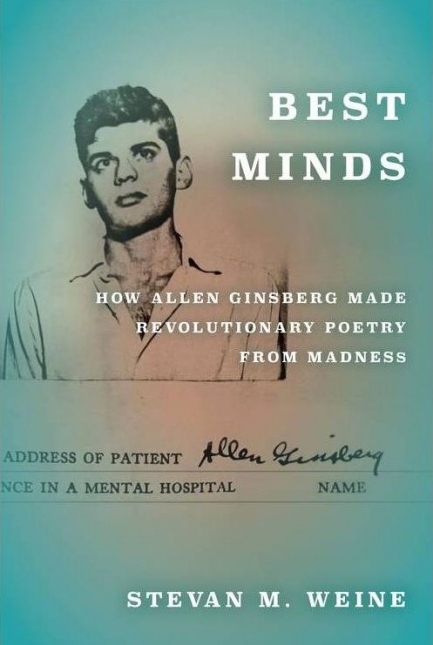Best Minds: How Allen Ginsberg Made Revolutionary Poetry from Madness
- By Stevan M. Weine
- Fordham University Press
- 304 pp.
- Reviewed by Mike Maggio
- March 31, 2023
A young psychiatrist-in-training studies the famed poet.

Allen Ginsberg, who revolutionized poetry with his seminal “Howl” and who was a major force in the Beat Generation and the “flower power” social revolution of the 1960s, was deeply influenced by madness. His mother, a schizophrenic, was hospitalized multiple times and subjected to the harsh treatments of the day, including electric shock therapy, insulin therapy, and toward the end, a frontal lobotomy that her poet son, still a young man, was obliged to authorize.
Ginsberg’s own madness manifested as feeling the “presence” of inanimate objects, having visions, and struggling with homosexuality (which, during the 1950s, was itself classified as a mental disorder). He associated with others of his generation who suffered from mental illness, including the Dadaist Carl Solomon, to whom “Howl” is dedicated.
Having gone through psychoanalysis and having been hospitalized, like his mother, at the Psychiatric Institute in New York, Ginsberg was well-acquainted not just with the disease but with the stigma attached to it and the approach physicians took to treating it. No wonder, then, that “Howl” begins, “I saw the best minds of my generation destroyed by madness.”
While literary scholars have long analyzed Ginsberg’s poetry for its connections to madness, few have had the ability or the privilege to do so through the lens of psychiatry. Enter Stevan M. Weine, whose Best Minds explores Ginsberg’s close association with mental illness and how it influenced him as a poet and activist.
In 1986, Weine was a medical student at Columbia University preparing to enter the field of psychiatry. Already a fan of Ginsberg’s work and interested in how madness was portrayed in literature, he managed to make the poet’s acquaintance. Perhaps surprisingly, Ginsberg, who’d long felt the sting of contemporary psychiatry via his mother’s hospitalizations and his own, gave Weine permission to examine both of their medical records.
Using these sources, Weine explores in depth the state of psychiatry in the 1950s and delves into the episodes of madness Ginsberg witnessed in himself and others. He then examines how those things led to Ginsberg’s development as a poet and, in particular, the influence they had on “Howl” and another iconic poem, “Kaddish.”
As the author reveals, Ginsberg’s struggles with madness and homosexuality, his friends’ episodes with mental illness, his mother’s descent into schizophrenia, and his guilt over having authorized her lobotomy all contributed to his artistic growth and to his eventual belief that madness is not the stigma that society decrees:
“Allen’s poetry expresses a commitment to personal, sexual, social, and political liberation in response to real-world threats to freedoms in the second half of the twentieth century. What Allen attempted in his writing and activism still inspires today, and this book shows what has come — culturally, intellectually, therapeutically, and politically — from Allen’s poetic, pragmatic and hopeful approach to madness — and how much can still be learned.”
Of particular interest is Ginsberg’s obsession with William Blake, the prophetic poet of the Romantic Era. In perhaps one of the most profound developments in Ginsberg’s life, he experienced a series of what he called his “Blake Visions,” in which he heard Blake’s voice “reciting poems, deep and ancient.” Writes Weine:
“The visions were a sensual experience of a spiritual visitation. They thrilled and frightened Allen. He basked in the delight of having made contact with the eternal. He was also terrified by the realization that so many people around him seemed to be oblivious to an eternal presence. Few people knew what he now knew about existence. The visions, which opened the doors to both heaven and hell, excited and frightened him like nothing else ever had.”
As Weine demonstrates, these visions enabled Ginsberg to reach a state in which poetry became “the central component of his life.”
Not only is Best Minds an examination of the influence of madness on Ginsberg and his work through the eyes of a psychiatrist, it is also a study of mid-20th-century psychiatry and the role Ginsberg played in fostering change in the field. Throughout the book, Weine attempts some literary analysis, yet this is not a literary study. Instead, it’s an analytical treatise that illuminates previously unknown details of the poet’s life. For this reason alone, it will be a valuable reference for future Ginsberg scholars.
Mike Maggio latest book of poetry is Let’s Call It Paradise.

